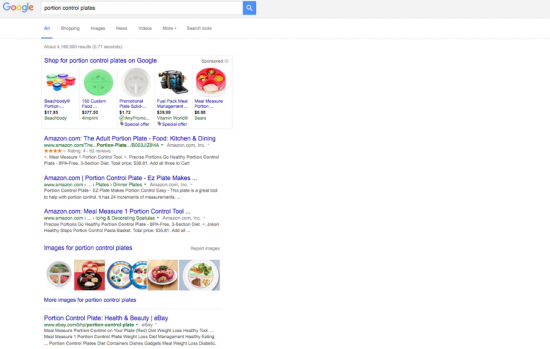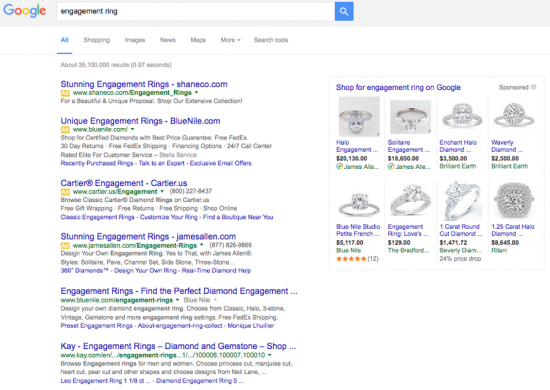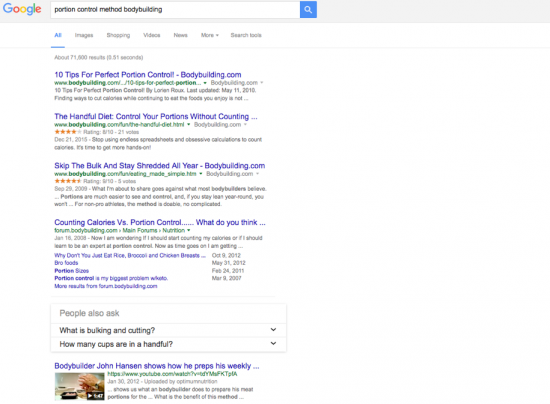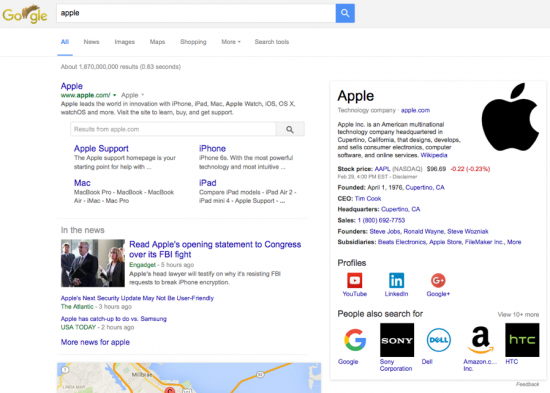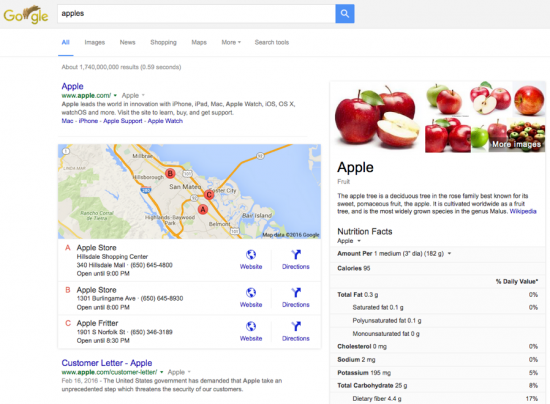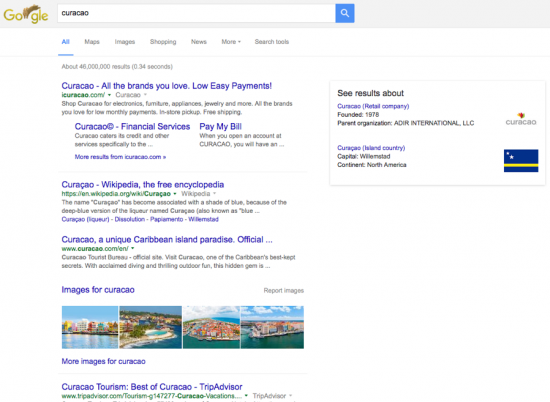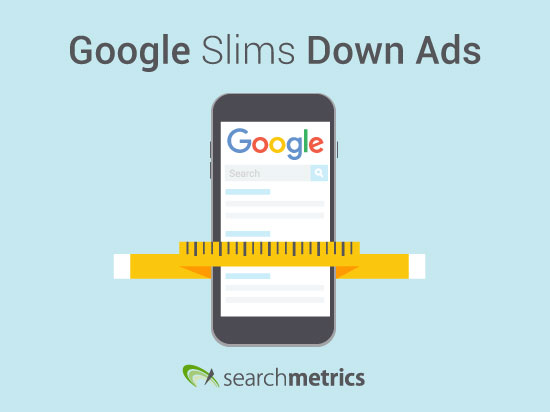
To the average person, Google’s search engine results page (SERP) looks no different today than it did a month ago. But for SEO experts, the SERP change is like noticing Google lost weight: all of a sudden, the results page really trimmed down. Google recently (in its usual quiet way) removed the right-rail ads running alongside the main part of the page that features both paid and organic listings.
Your part of the conversation should’ve gone something like this:
“Wow, Goog! You’re looking pretty good these days! Lost weight?”
“You noticed! Yes, I’ve trimmed down a bit. No more fatty right-rail ads for me!”
Here you see how Google handles a recent search for “portion control plates:”
Notice the glaring white space and absence of right-rail ads? Very slimming.
In some cases, we’ve observed that right-rail ads are primarily being served when “highly commercial queries” or those transactional in nature, occur. But these are hard to come by since Google is phasing out right rail ads completely. Never fear, a search for ”engagement ring” achieves a similar result, but showing Sponsored ads. This isn’t quite the same as the stacked rail of ads but similar in that the space is still being utilized for paid placement.
What does it all mean?
There is only so much room on page 1, which means increased competition for organic spots when paid placements stack up on top. We see this for longer tail queries (ie “portion control method bodybuilding”), with the emergence of elevating related searches as a dropdown box labeled “People also ask.” Here we see related searches integrated into page 1. In this instance, the search resulted in fewer organic results and integrated at least two video results.
Without a doubt, four ads leading the results means a squeeze for organic listings. In some cases, the classic 10 organic results are listed, but there’s going to be a fight to hold onto the #10 spot because everyone on Page 2 wants a shot at ranking on the first page. Alternatively, in the case where fewer organic results appear (sometimes only up to 7), it could mean less clicks from organic traffic.
In a way, you could speculate that removal of right-rail ads streamlines the look of the SERP and lends itself better to the parameters a mobile screen. It’s no surprise that Google is prioritizing mobile first based on data that shows mobile search queries surpassed desktop.
This also ushers in increased CPC rates for these prime four ad slots.
Advice for online marketers and SEO’s
Let’s look at this like a plate of food. In the same way that the desire to either lose or gain weight depends on what you put on your plate, a balance of vegetables, protein and whole grains is the healthier option. Whereas, a plate consisting only of a cheeseburger and fries means your health will quickly go out the window. It’s the same for Google where their SERP reflects the need for portion control between organic and paid listings.
Google is essentially weeding out the fat of its right rail ads in an effort to streamline listings into its services that are already working. Since theirs is the hand that’s serving, there is a constant balance between where and how ads are served amidst purely organic results pages.
The rail of organic opportunity
Paid listings may continue to push organic listings below the fold, but the right rail presents an opportunity for organic content to surface accordingly. Especially as Google’s artificial intelligence is continuously improving, they’re looking to understand the intent behind search queries. To illustrate, here’s a SERP for the term “apple.” We can see Google has determined the most effective listings related to this query is information about the company, Apple Inc.:
Whereas, the plural version of the same term, “apples,” brings up a different view entirely; this SERP has more to do with apples in general as a fruit:
This is further proof that Google’s AI is able to discern the search intent even in the face of such nebulous terms; between entities and things. In cases where they can’t yet stipulate two different SERPs, the page reflects options for both. For example, a search for “curacao:”
Final thoughts and advice
First, we have to stay calm. Much of SEO is about adapting to the continually changing conditions imposed by Google; things change more frequently than you might imagine.
Second, get good at publishing content that addresses the needs of your consumer by becoming a topic authority by designing pages that specifically answer a question and provide useful elements that further serve the user. Remember, create content for humans (not search engines). Ultimately, content should be optimized so that it surfaces in places like organic search, the Knowledge Graph, Rich Answers or app searches.
Third, focus on optimal formatting for how your listing appears in the SERP. There are actual numbers that provide the parameters for the optimal length and visibility of title tag and meta description. Heed them. It’s also a good time to ensure you are integrating keywords and a call to action to capture CTR.
Nearly 70% of all searches start with one of these words: who, what, where, how.
Publishing consistently on topics related to your industry in service of your ideal customer will establish your brand and products as the authority in the space come what may of the SERP landscape.
What does it all mean? At this point, the SERP is still anybody’s game for organic – and a jump ball for paid. There’s likely to be a massive land grab for the top four paid advertising spots, which means costs will rise in kind. At Searchmetrics, we’re continuing to collect data and research the impact this is having on key consumer product categories. Expect a followup post after we gather new information.
If you’ve experienced any impact or changes with the removal of right rail ads, let us know in the comments below!

